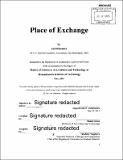| dc.description.abstract | The thesis is written as a theoretical presentation of the research I conducted at MIT between 2013 and 2015. I will discuss what I consider to be an important aspect of my artistic practice; creating places of exchange, through the works I have made at MIT, and through past projects and works (2002-2013). I will deal with the following questions: What does place of exchange mean? How do I create this? And for whom is it made? The term "place of exchange" is meant to replace the traditional term for art in public space, "public art." I argue that the term public art has been worshipped in the last decades by institutions, academia, curators, art historians, and artists. This term gives more importance to the location of the work, and the possible function it can or should have, than to the Public it is supposed to address. The space in which any work is built does not automatically turn the work into a public artwork. It is not only the space the work creates, but also the time the work creates, that turns a work into a public artwork. What I consider to be important in public space is the place of the Public in relation to the situation any artwork creates (it can be visual, auditory, written, performed, or printed). That created space is not "public" because of its existence, but because it managed to interact with and demand the public's time. What does "public time" mean? Both the artist and the artwork are seeking the actual time people can share with the work to enable a discussion, an exchange. What does attract and bring the public to interact and become active? How can the work invoke a spectator to question, doubt, and take/give time? I discuss in this thesis other aspects of my practice in relation to my research and final proposal. These are aspects such as: dialogue with the space the work will be built in (the medium; a room, a square, a book, or a poster), the surrounding (architecture), the history, the function, and the theme I am interested in questioning (context and content), as well as the individual perspective of the spectator (be it visual, sensual, intellectual, or physical). My aim is to create a work where an exchange can take place, where my participation or agency can come into play. In the thesis open conclusion, I present my current project: KARADA, an experimental opera installation. The project is a proposal for a stage/art installation that embraces both the performer and the audience. The visitor/spectator/audience/occupiers become both at once, through their movement in the space and through the physical experience of the music by means of vibration. The individual activates the sound by touch sensors, and conducts his experience in relation to his and other spectators' movement and interaction within the space and with its objects. | en_US |
